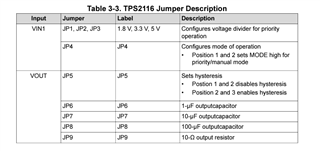Other Parts Discussed in Thread: TPS2116
Good evening,
I am currently using TPS2116EVM, I have connected two amperemeters on VIN2 and VIN1 inputs (both are operating at 3.3Volts) to check the current consumption. I have connected a Load Resistor of 10kOhm instead of using the 10R Load Resistor on VOUT as I need to measure the leakage current when my device is in sleep mode ( approx. 330uA).
I need to use ST Pin to create an Interruption on the MCU when the Power path change.
when ST Pin is pulled up to Vout (config, with JP5 Jumper), I have observed a current consumption 660uA on VIN2 (when selected ) and +540 uA on VIN1 (when selected).
If I leave ST Pin floating or if I connect ST Pin to PR1 , I have a current consumption of approx. 330 uA on both VIN1 and VIN2. I confirm the quiescent current of TPS2116 .
It seems having ST pulled-up to Vout is considered as a load , and I would like to optimize the power consumption of my board.
I see several solutions:
- Using a higher Impedance pull-up 1 to 10 MOhm to decrease the current consumption
- connecting ST Pin to PR1, then I need to provide a higher voltage on VIN1 (on the EVAL board) due to Heresis effect ( I am using your excel document provided on the forum) ,
- pulling down ST PIn with 10K ohm resistor,
I have noticed a small mistake on the table 3.3 , page 3 of the Eval board user guide ( ref SLVUBZ0A – NOVEMBER 2020 – REVISED DECEMBER 2020)
maybe you meant
Position 2 and 3=> disable hysteresis
Position 1-2 => enable Hysteresis

thanks for your support,
damon

